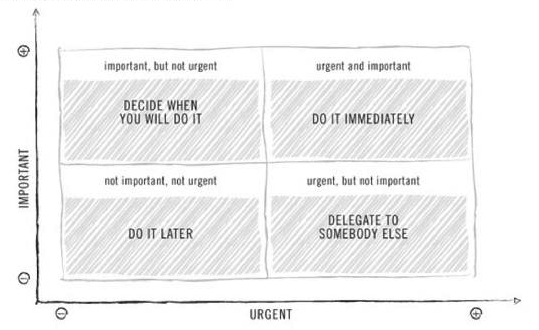The Eisenhower Matrix is a powerful tool that helps you work on the most important thing and get more done. Let’s explore how it works so you can put it to use today.
Dwight Eisenhower wasn’t only the 34th President of the United States. Before that, he was a five-star general in the Army, responsible for command of the Allied Forces in Europe during World War II. He was also the Supreme Commander of NATO and President of Columbia University.
Eisenhower avoided the trap many of us fall into when we confuse efficiency with effectiveness.
No matter the role or the environment, Eisenhower consistently delivered for decades.
The simple tool he created so he never confused the important with the urgent helps us prioritize our time.
How did he accomplish so much?
Eisenhower used a simple tool called the Eisenhower Matrix. It’s an effective time management strategy you can put to use today.
The Eisenhower Matrix
The Eisenhower Matrix has four parts, which you use to categorize the work in front of you:
- Important, but not urgent
- Urgent and important
- Urgent but not important
- Not important and not urgent
The Eisenhower Matrix helps you prioritize your time.
The real value of the tool is how it helps you distinguish between what is important and what is urgent. As Eisenhower said, “What is important is seldom urgent and what is urgent is seldom important.”

The Difference Between Urgent and Important
Urgent tasks are time-sensitive and demand immediate attention. These tasks can range from responding to emails and returning phone calls to picking up groceries on the way home for dinner. If you can’t eliminate urgent tasks, tackle them with ruthless efficiency.
In contrast, important tasks propel us forward with vision and meaning. They are the things we want to accomplish that align with our values and goals, bringing us a sense of purpose. Important tasks require effectiveness.
We often feel stressed and overwhelmed when we tend to focus on urgent but unimportant tasks. While these are easy to check off our list and give us a sense of accomplishment, they don’t move us forward.
We get into trouble when we confuse efficiency and effectiveness.
The key to productivity is doing more of what matters and less of what doesn’t.
The most powerful productivity hack in the world is simply the word no. All the time you spend on something that doesn’t matter comes at the expense of something that does matter. Not doing something is faster than doing it.
The most productive people not only understand the difference between urgent and important tasks, but they also ruthlessly eliminate nearly everything else. By concentrating their mental and physical energy in the right place, they maximize their impact.
Think of this as the surface area of attention. The more projects you have on the go, the more area you have to keep track of, and the more energy you spend staying up to date rather than making actual progress.
To reduce the surface area of your attention, ask yourself the difficult question of whether what you are doing truly matters to the outcome you want. Most of what you are doing doesn’t move you closer to your goals. If you are ruthless, you can eliminate 30-50% of what you are doing without impacting the most important things. Invest the time you save in what matters most.
The most urgent decisions are rarely the most important ones.
Dwight Eisenhower
Admitting that you’re doing something that doesn’t matter feels like failure. It’s like admitting that what you’ve been doing up until now was wrong. It’s much easier to keep doing what we’ve been doing and tell ourselves that if we just worked harder or longer, we’d make more progress.
The Difference Between Busy and Productive
Being busy and being productive are not the same thing. It’s easy to be busy. It’s hard to be productive. I think of being busy like running in a circle. It doesn’t matter how fast you go, you’re not really getting anywhere.
The real “work” of productivity is less about improving efficiency (going faster) and more about improving effectiveness (going toward the destination).
Being productive is not about doing more; it’s about concentrating the most energy possible on the things that matter.
Using the Eisenhower Matrix in Practice
I’ve found the Eisenhower Matrix helps me eliminate the unnecessary and separate my time into two buckets: effective and efficient. Effective time is big chunks on the important things. Efficient time is little chunks on things I need to move forward quickly. My mornings are for Effective time. My afternoons are for efficient time.
Drop all non-important and non-urgent tasks. This one is easy.
Effective time. Schedule important and non-urgent tasks into your calendar. Block off the best 60-90 minutes of your day and make it untouchable. This is when you are effective and create long-term value. This time is for your biggest opportunity.
Efficient time. Important and urgent tasks should be scheduled. Block 60-90 minutes in your afternoon and go through your list as efficiently as possible. When you have too many of these tasks, it’s a sign to step back and think. For the last 1/3 of this time, I ruthlessly tackle all of the urgent and non-important tasks that I can’t delegate. While these tasks often require attention, they don’t always require your attention.
Understanding the difference between tasks that should be done effectively, ones that should be done efficiently, and ones that shouldn’t be done at all will help supercharge your productivity. Invest the best time of your day in the biggest opportunity, not the biggest problem.
Still curious? Check out The Decision Matrix: How to Prioritize What Matters.
